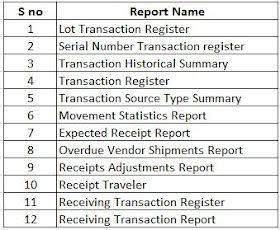Oracle SCM Functional Interview Questions
& Answers - Order Management Module - Part VI
Question
& Answers on Drop Shipment Orders
Define Drop Shipment?
Oracle
Order Management & Purchasing integrate to provide Drop Shipments.
Drop
Shipments are orders for items that supplier ships directly to the customer
either because stock nil or currently don't have the items in inventory, or
because it's more cost effective for the supplier to ship the item to the
customer directly.
How is a Drop Ship Purchase
Order created?
Drop
Shipments are created as Sales Orders in Order Management. Purchase Release
concurrent program or workflow in Order Management creates rows in the
Requisition Import tables in Purchasing. Then Purchasing's Requisition Import
process creates the requisitions. Drop Shipments are marked with the Source
Type of External in Order Management and Supplier in Purchasing.
Item Attributes setup
required for Drop Shipment item?
Item
Attributes setup steps for the Drop Ship item
How to avoid the
miscounting of supply as logical organization is involved?
Drop-ship
items must be received in a logical organization.
If
Oracle master Scheduling/MRP and Oracle Supply Chain Planning is used to avoid
miscounting supply it’s not necessary to include logical organizations in the planning.
If logical organizations is included in the planning, ensure that doing so does
not cause planning and forecasting complications.
If any changes are made in
a Sales Order after the Purchase Order (PO) has been generated, will the order
changes automatically be updated on the PO?
Order
changes will not be automatically updated on the PO. Pulling up the Discrepancy
report will allow to view the differences between the Sales Order and PO.
However, user has to manually update the POs in the Purchasing application.
If items on a Drop Ship
order are cancelled, does the system automatically generate a PO Change to the
PO originally sent to the supplier?
No,
user has to manually verify the discrepancy report which will report
differences between the PO and the Sales Order.
Does Order Management 11i
have functionality to do serial number management with Drop Shipments?
Serial
numbered can be received in Drop Ship stock. Order Management will receive the
serial number noted on the PO.
Can Configurable Items be
Drop Shipped?
Currently
only Standard Items can be Drop Shipped.
Is
it possible to perform Drop Shipment across operating units?
Release
11i does not currently support this functionality.
How are over/under
shipments handled in Drop Shipment?
If
part of a drop-ship line ships and user do not wish to fulfill the remaining
quantity, cancel the line. Over shipments must also be handled manually. If the
supplier ships more than the ordered quantity, user can bill your customer for
the additional quantity or request that they return the item. Use the Drop Ship
Order Discrepancy Report to view differences between the drop-ship Sales Orders
and their associated purchase requisitions and orders.
Is it possible to create
releases based on drop shipment orders for the items in the blanket agreement
when a valid Blanket PO is created?
Yes,
it is possible to create releases from drop ship orders automatically or via
Autocreate window, if the drop ship Requisition has the correct Blanket
Information (Source)
Approved
Supplier List to be set for the supplier site desired.
Depending
on the hierarchy determine which assignment better suits and define
sourcing rule according to the required level with the required supplier site.
Also
ensure that ASL entry exists for the above supplier/site.
For
automatic sourcing to be done also set profile 'PO: Allow Automatic
Sourcing' to Yes so that the source document will be determined automatically
depending on the creation dates and the type of the document.
Is it possible to cancel
Drop Shipment after it is received?
Drop
Shipments cannot be cancelled once Oracle Purchasing obtains the receipt. A
user who wants to cancel a Drop Ship Sales Order line must ensure no receipts
have been created against the line and that the requisition and/or Purchase
Order associated with the line is cancelled. Cancellation of a Partial Drop
Ship receipt is allowable. But only the portion that has not been received can
be cancelled. If a Drop Shipment line is cancelled for which the entire
quantity is not shipped, the order processing splits the line. The first line
contains the quantity shipped and the second line contains the non-shipped
quantity in backorder. Now the second line the backorder on the Sales Order can
be cancelled. The PO line quantity should be changed to reflect the new
quantity.
What is the Import source
and status of PO generated from Drop Shipment?
Import
source for the Drop Shipment orders will be Order Entry & Status of PO will
always be Approved.
Can we receive a PO
Shipment for which the related Sales Order Line is Cancelled / Closed?
PO
Shipments for which relates Sales Order line has been cancelled or closed
cannot be received. The PO shipment should be cancelled. A new Sales Order Line
should be created, if needed.
Reference: Collected
from various web sources
Please do refer:








